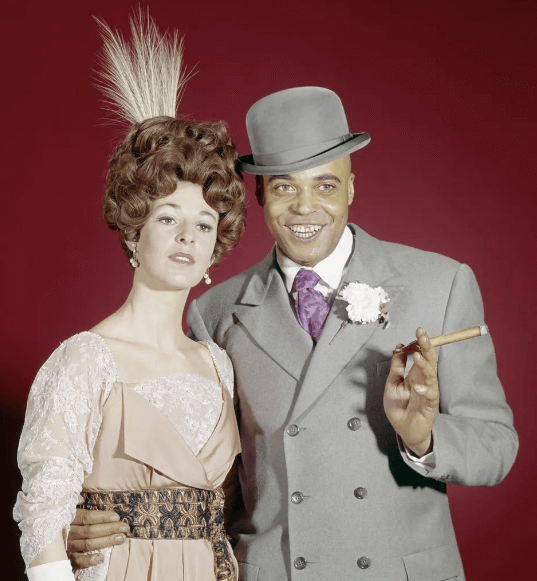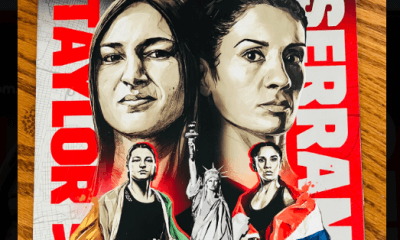Featured Articles
The Hauser Report: James Earl Jones and More

A word of remembrance about James Earl Jones who died on September 9 at age 93.
Born in Mississippi during the height of segregation, raised by his grandmother after being abandoned by his parents, and plagued by a stutter so severe that he often refused to speak when he was young, Jones became one of the great actors of modern times. During a storied career on stage, in movies, and on television, he was honored with an Oscar, a Tony, and an Emmy. He was the voice of Darth Vader in Star Wars and Mufasa in The Lion King and known the world over for his iconic intonation “This is CNN.”
“Audiences,” Robert McFadden wrote, “were mesmerized by the voice. It was Lear’s roaring crash into madness, Othello’s sweet balm for Desdemona, Oberon’s last rapture for Titania. He liked to portray kings and generals, garbage men and bricklayers.”
Jones was recognized in theatrical circles as an extraordinary talent for years. But boxing propelled him to mainstream stardom.
In 1968, The Great White Hope opened on Broadway with Jones (6-feet-2-inches tall, 200 pounds) in the role of Jack Jefferson – a character modeled on Jack Johnson. Jones didn’t like boxing. “I’m not and never have been a fan of boxing,” he told me years later. “I had an unfortunate experience at a fight I went to long ago in Spain. A Nigerian fighter was killed in front of my eyes.”
But Jones played the role of Jack Jefferson to perfection and, two years later, reprised the role in the film adaptation. I had the honor of interviewing him when I was researching Muhammad Ali: His Life and Times.
“I met Muhammad Ali for the first time backstage after a performance of The Great White Hope, “Jones reminisced. “Ali was still not allowed to fight, and meeting him was exciting, particularly given his response to the play he’d just seen. He said of Johnson, ‛That’s me. You take out the white woman, and that play is about me.’ Then he told me, ‘I want to go on stage and say those lines.’ He was referring to the scene where the Jack Johnson character is in exile in Europe. He’s been reduced to performances of Uncle Tom’s Cabin to earn a living, and the powers that be keep pursuing him, hoping to get him to agree to a title fight with a prearranged loss. Finally, they talk him into coming back to fight with the idea of turning the crown over to Jess Willard in Cuba. And the character says, ‘Come get me. Here I is!’
“We waited until the audience had left,” Jones continued. “Then Ali went out onto the stage and spoke to an empty theater. ‘Here I is! Here I is!’ He felt those lines expressed his life, and he spoke them with feeling.”
As for Ali’s own acting ability, Jones contemplated Muhammad’s extraordinary charisma and noted, “I wondered at the time, could he translate that into the craft of acting, which is using somebody else’s lines, which is the most difficult thing for any natural performer to do? I never saw him when he played in Buck White, because I was working somewhere else myself. I did see him on television much later in Freedom Road. And I played Malcolm X in two very short scenes in The Greatest, where Ali played himself but was essentially reading someone else’s lines. And what I found was, given his own words he was a great performer. But given somebody else’s words, there was a self-consciousness that he was unable to overcome. So he wasn’t a great craftsman in the art of acting, but that by no means takes away from his accomplishments. Ali represents America to me; power at its best, power well used, because real power is individual power. And each time we reconsider Ali, we realize there’s more to him and more value than we realized before.”
And there was a footnote to it all.
“Ali visited the set at Twentieth Century Fox when we were filming The Great White Hope,” Jones recalled. “We got in the ring together. We were both wearing boxing gloves. The photographers were busy flashing. Muhammad said, ‘Go ahead, hit me as hard as you can.’ Well, I’d played the Jack Johnson character since the play opened on Broadway. I‘d been put through my paces by real boxing trainers. So I gave Muhammad my best left hook. He blocked the blow. And in the process, quite accidentally, he broke my thumb. You know, when a fighter like Ali blocks a punch, the block is devastating in its own power. I felt the pain immediately.”
***
The main event at Madison Square Garden between Sandy Ryan and Mikaela Mayer didn’t start until Saturday morning at 12:45 AM. But it was worth the wait.
Ryan, age 31, came into the fight with a 7-1-1 (3 KOs) record. She won the WBO 147-pound title by decision over Maria Pier Houle last year, kept it on a draw against Jessica McCaskill, and stopped Terri Harper in four rounds this past March.
Mayer, age 34 (and now 20-2 with 5 KOs), once held the WBO 130-pound belt but lost a close decision in a title-unification bout against Alycia Baumgardner two years ago. She has since moved up to welterweight and was narrowly defeated by Natasha Jones in an IBF title fight in January of this year.
An element of bad blood was injected into the proceedings when trainer Kay Koroma (who had previously worked with Mayer) began working with Ryan, leaving Mayer in the hands of Kofi Jantuah. Then, as Team Ryan was leaving its hotel for Madison Square Garden on fight night, an attacker wearing a hoodie splashed Sandy with red paint and escaped in a waiting car with an accomplice.
Ryan was a slight betting favorite. The encounter shaped up as a competitive fight but turned out to be much more than that. It was an exceptionally good, non-stop action battle.
Ryan moved inexorably forward and Mayer couldn’t keep her off. But it wasn’t always effective aggression and Mikaela held her own on the inside. Each woman went effectively to the body which is a weapon often absent from the arsenal in women’s boxing. Both fighters were in good shape. Ryan was physically stronger.
It was a hard fight to score. According to CompuBox (which is an inexact science) Mayer landed 186 punches to Ryan’s 185. All three judges gave rounds eight and ten to Mayer. Those were the only rounds they scored alike.
I thought each woman clearly won three rounds with the other four up for grabs. The judges scored the bout 97-93, 96-94, 95-95 for a majority decision in Mayer’s favor.
A rematch is definitely in order.
***
Question: What do Hall of Fame promoter Bob Arum (who oversaw the fights that stretched from 6:40 on Friday evening till 1:20 on Saturday morning), Mae West, Bobby Fischer, and Barbra Streisand have in common?
Answer: They all went to Erasmus Hall High School in Brooklyn.
Erasmus was founded in 1786 as a private institution and became part of the New York City public school system in 1896. Arum graduated in 1949 and is one of the school’s many famous alumni.
Erasmus graduates who made a mark in the National Football League include Hall of Fame quarterback Sid Luckman, owner Al Davis, and coach Sam Rutigliano. Jerry Reinsdorf (who owns the Chicago Bulls and Chicago White Sox) and baseball hall of fame pitcher Waite Hoyt went to Erasmus, as did NBA all-star forward and championship coach Billy Cunningham.
Bobby Fischer (arguably the greatest chess player of all time) attended Erasmus. So did former New Jersey governor James Florio and author Mickey Spillane.
Then we come to the world of entertainment. Oscar winner Susan Hayward and opera diva Beverly Sills (whose original name was Belle Miriam Silverman) are on the list of Erasmus attendees. So is Mae West (the quintessential sex symbol of the 1920s and 1930s who at one point was the highest-paid woman in the United States and starred in films opposite Cary Grant).
“I never met Mae West,” Arum says. “But I enjoyed watching her movies; that’s for sure.”
Record company executive Clive Davis (who graduated from Erasmus and counts Bruce Springsteen, Janis Joplin, and Billy Joel among his signees) is a lifelong friend of Arum’s.
“Neil Diamond, I know because he wrote Sweet Caroline,” Arum adds, referencing another Erasmus alumnus. “That’s boxing’s new anthem, and my granddaughter’s name is Caroline.”
And finally – drumroll, please – there’s Barbra Streisand (Erasmus, Class of 1959). “I’ve met her,” Arum recounts. “But she wasn’t very friendly.”
***
The New York State Athletic Commission took a step in the right direction on Saturday when Matt Delaglio was named executive director.
Delagio served as director of boxing during the rocky tenure of Kim Sumbler who resigned as executive director in May of this year. He was then designated as acting executive director, but there were fears in boxing circles that he would be passed over for the job on a permanent basis in favor of a less qualified political appointee. Those fears have now been laid to rest.
The next thing Governor Kathy Hochul needs to do is upgrade the NYSAC at the commissioner level.
In theory, the NYSAC is overseen by five commissioners. Two of these positions are currently vacant. Too often, NYSAC commissioner appointments are made as trade-offs for political favors. The result is that, because of uninformed leadership, the NYSAC has been known to embarrass itself.
Delagio is a hard worker and conscientious public servant who understands the sport and business of boxing. It would be nice if Governor Hochul appointed two new commissioners who understand the sport and business of boxing as well as he does and have the same commitment to public service that he has.
PICTURED: James Earl Jones and Jane Alexander, his co-star in the Broadway and film versions of “The Great White Hope.”
Thomas Hauser’s email address is thomashauserwriter@gmail.com. His most recent book – MY MOTHER and me – is a personal memoir available at Amazon.com. https://www.amazon.com/My-Mother-Me-Thomas-Hauser/dp/1955836191/ref=sr_1_1?crid=5C0TEN4M9ZAH&keywords=thomas+hauser&qid=1707662513&sprefix=thomas+hauser%2Caps%2C80&sr=8-1
In 2004, the Boxing Writers Association of America honored Hauser with the Nat Fleischer Award for career excellence in boxing journalism. In 2019, Hauser was selected for boxing’s highest honor – induction into the International Boxing Hall of Fame.
To comment on this story in the Fight Forum CLICK HERE
-

 Featured Articles4 weeks ago
Featured Articles4 weeks agoAvila Perspective, Chap. 330: Matchroom in New York plus the Latest on Canelo-Crawford
-

 Featured Articles3 weeks ago
Featured Articles3 weeks agoVito Mielnicki Jr Whitewashes Kamil Gardzielik Before the Home Folks in Newark
-

 Featured Articles21 hours ago
Featured Articles21 hours agoResults and Recaps from New York Where Taylor Edged Serrano Once Again
-

 Featured Articles4 weeks ago
Featured Articles4 weeks agoCatching Up with Clay Moyle Who Talks About His Massive Collection of Boxing Books
-

 Featured Articles5 days ago
Featured Articles5 days agoFrom a Sympathetic Figure to a Pariah: The Travails of Julio Cesar Chavez Jr
-

 Featured Articles3 weeks ago
Featured Articles3 weeks agoMore Medals for Hawaii’s Patricio Family at the USA Boxing Summer Festival
-

 Featured Articles1 week ago
Featured Articles1 week agoCatterall vs Eubank Ends Prematurely; Catterall Wins a Technical Decision
-

 Featured Articles4 weeks ago
Featured Articles4 weeks agoRichardson Hitchins Batters and Stops George Kambosos at Madison Square Garden




















